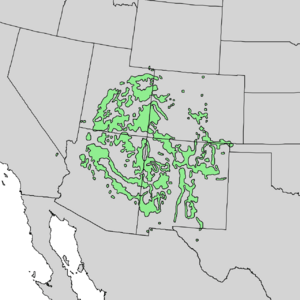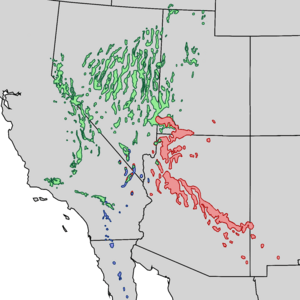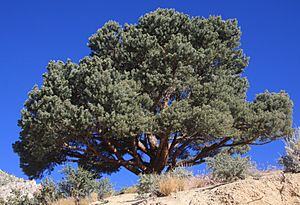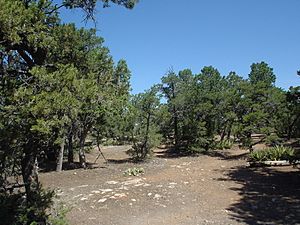Pinyon pine facts for kids
Quick facts for kids Pinyon pines |
|
|---|---|
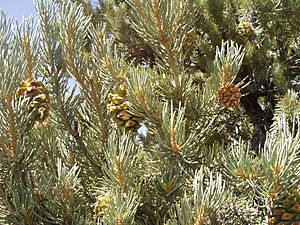 |
|
| Single-leaf pinyon (Pinus monophylla subsp. monophylla) | |
| Scientific classification |
|
| Kingdom: | Plantae |
| Clade: | Tracheophytes |
| Division: | Pinophyta |
| Class: | Pinopsida |
| Order: | Pinales |
| Family: | Pinaceae |
| Genus: | Pinus |
| Subgenus: | P. subg. Strobus |
| Section: | P. sect. Parrya |
| Subsection: | P. subsect. Cembroides Engelm. |
| Species | |
|
See text. |
|
Pinyon pines, also called piñon pines, are special trees found in the southwestern parts of North America. You can mostly find them in places like New Mexico, Arizona, and Utah. These trees are famous for their yummy, edible seeds, which are called pine nuts.
For a long time, pine nuts have been a very important food for Native Americans. Today, many people enjoy them as a snack or use them in cooking, especially in New Mexican cuisine. The name "pinyon" comes from the Spanish words pino piñonero, which means "pine nut pine." This name is used for both the American pinyon trees and a similar tree in Spain called the stone pine.
Pinyon wood has a unique, pleasant smell when it burns. This makes it a popular choice for fires in outdoor fireplaces called chimeneas. These trees also help the soil they grow in by adding important nutrients.
Some pinyon species can even mix their genes to create new types of trees. For example, P. quadrifolia and P. monophylla sometimes create a hybrid tree. The two-needle piñon (Pinus edulis) is so special that it's the official state tree of New Mexico.
Contents
Types of Pinyon Pines
There are several different kinds of pinyon pines. Scientists group them together because they share many features. Here are some of the main types of true pinyon pines:
- Pinus cembroides – Mexican pinyon
- Pinus orizabensis – Orizaba pinyon
- Pinus johannis – Johann's pinyon
- Pinus culminicola – Potosi pinyon
- Pinus remota – Texas pinyon
- Pinus edulis – Two-needle piñon or Colorado pinyon
- Pinus monophylla – Single-leaf pinyon
- Pinus quadrifolia – Parry pinyon
Other related trees, mostly found in Mexico, are also called pinyons:
- Pinus rzedowskii – Rzedowski's pine
- Pinus pinceana – Weeping pinyon
- Pinus maximartinezii – Big-cone pinyon
- Pinus nelsonii – Nelson's pinyon
The bristlecone pines, which grow in the high mountains of the southwestern United States, and the lacebark pines from Asia, are also close relatives of the pinyon pines.
Pinyon Nuts: A Traditional Food
The seeds from pinyon pines, known as "pine nuts" or "piñóns," are a very important food for American Indians who live in the mountains of the North American Southwest. While all types of pine trees produce edible seeds, pinyon pines are special in North America because their seeds are big enough to be a major food source.
People have likely been eating pinyon nuts since humans first arrived in the Great Basin and American Southwest. In the Great Basin, old discoveries show that pinyon pines spread northward after the last Ice Age, reaching their current northern limit around 4000 BCE. Early Native Americans certainly gathered these tasty seeds. However, evidence of large-scale pinyon nut harvesting only started appearing around 600 CE. This increase in use might have happened because more people lived in the Great Basin, and there were fewer game animals to hunt. This meant people needed to find other food sources.
One challenge with pinyon nuts is that the harvest isn't always reliable. A lot of cones and seeds only grow every two to seven years. On average, a good harvest happens about every four years. When there's a good year for seeds, it often happens across large areas where pinyon trees grow.
How Pinyon Nuts Are Harvested
In 1878, a naturalist named John Muir described how Native Americans in Nevada collected pinyon seeds. In September and October, they would use long poles to knock the cones off the pinyon trees. Then, they would pile the cones up, put brushwood on top, and light it. The fire would lightly scorch the cones. This scorching helped burn off the sticky resin on the cones and made the seeds easier to remove. After that, the cones were dried in the sun until the seeds could be easily taken out. Muir said that the Native Americans watched the pinyon trees all year and could tell if the harvest would be big or small months before it was time to collect.
In 1891, another observer, B. H. Dutcher, saw the Panamint Indians (who are part of the Timbisha people) harvesting pinyon seeds near Death Valley, California. Their method was similar, but they took the seeds out right after the cones were scorched in the fire.
Both of these ways involved getting the seeds from green cones. Another way is to let the cones stay on the trees until they are dry and brown. Then, people hit the cones with a stick, causing the cones or the seeds to fall to the ground, where they can be gathered. The nomadic hunter-gatherer people of the Great Basin usually ate their pinyon seeds during the winter after the harvest. The farming Pueblo people of the Rio Grande valley in New Mexico could store their seeds for two or three years in special pits.
Each pinyon cone can produce 10 to 30 seeds. In a good year, a healthy group of pinyon trees on one acre of land can produce about 250 pounds (113 kg) of seeds. An average person can collect about 22 pounds (10 kg) of unshelled pinyon seeds in a day. This amount of seeds, even after shelling, provides nearly 30,000 calories of food. This is a lot of food for the effort, especially for people who rely on hunting and gathering. Plus, pinyon seeds are rich in fat, which was often hard for hunter-gatherers to find.
Pinyon Pines and Wildlife
Pinyon pines are very important for many animals. The pinyon jay bird, for example, gets its name from the tree because pinyon nuts are a big part of its diet. This bird is super important for helping new pinyon trees grow. It buries many seeds in the ground to eat later. Any seeds it doesn't eat are in a perfect spot to sprout into new trees. The Mexican jay also helps spread some pinyon seeds, and sometimes the Clark's nutcracker does too. Many other animals also eat pinyon nuts, but they don't help spread the seeds like these birds do.
See also
 In Spanish: Pinos piñoneros para niños
In Spanish: Pinos piñoneros para niños


